





May I interest you in a fine selection of fruit and nuts? Choosing the right feed to serve your backyard bird feeders may seem daunting. This helpful introduction to bird feed is a second in a four-part series on backyard birds.
Over the past 25 years, as the love of gardening has grown, so has the love of backyard bird watching. The wide selection of bird feeding products and supplies on the market prove more nature lovers and gardeners than ever are feeding birds every year. Choosing the right feeder sometimes involves knowing what type of seed you want to offer. But what kind of seed should you buy? Varieties are numerous and each type of seed has its advantages and disadvantages. Before you choose a feeder and seed, you'll want to learn what birds in your area you are likely to attract. Bird-watching friends will tell you with great enthusiasm about local bird sightings. Several surveys are available each year where citizen scientists record bird sightings. Project FeederWatch examines the North American winter birds from November to April. The Great Backyard Bird Count (GBBC) enlists citizen scientists to spend a weekend counting birds in their area. The results of both of these surveys are available for viewing on the website by species or location. Reviewing local results is a great way to see what birds are in your area.
What do birds eat? Backyard birds eat mostly seeds but many are also fruit and/or insect eaters. Here's a basic look at types of foods you may offer your feathered friends.
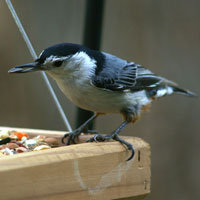
Sunflower Seeds — These seeds come from differing sunflowers. They generally can be found in two types: black oil and stripe. The black oil sunflower seeds (or BOSS) are more popular with birds because of their thin shells and higher oil content. Striped sunflower seeds are ideal for larger birds with stronger bills to crack the hard shells. Shelled sunflower seeds eliminate the mess of discarded hulls while hearts and chips are often available for smaller songbirds. Many premium mixes contain these bits of seed. If you buy only ONE type of seed, let it be this one. You won't be disappointed.
Safflower — This white seed is prized because squirrels, grackles and starlings reportedly don't like it. It is also a high-energy seed that attracts desirable songbirds like cardinals, nuthatches, grosbeaks, finches and titmice.
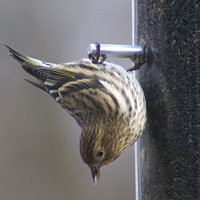 Nyjer — A favorite of gold finches, nyjer is the very small black seed of the nyjer plant cultivated in Asia and Africa. It is another seed prized for its high calorie and oil content. The small seed size makes it necessary to use a special feeder for this seed. Finches favor this seed in tube feeders or socks and ground feeding birds like dark-eyed juncos and doves forage for seed on the ground. Because it is an import, it is an expensive seed for purchase in the United States. Don't count on growing your own as it is heat-sterilized before packaging, a condition of import. This seed is also known as thistle, though it is not a thistle or member of the thistle family.
Nyjer — A favorite of gold finches, nyjer is the very small black seed of the nyjer plant cultivated in Asia and Africa. It is another seed prized for its high calorie and oil content. The small seed size makes it necessary to use a special feeder for this seed. Finches favor this seed in tube feeders or socks and ground feeding birds like dark-eyed juncos and doves forage for seed on the ground. Because it is an import, it is an expensive seed for purchase in the United States. Don't count on growing your own as it is heat-sterilized before packaging, a condition of import. This seed is also known as thistle, though it is not a thistle or member of the thistle family.
Millet (white and red) — Although millet can be a term for a group of cereal grains, most millet on the market is proso millet. Proso millet comes in red and white varieties and is often found in seed mixes on retail shelves. It is difficult to find sold alone so you'll need to try online sources or specialty feed stores to obtain it. Birds that prefer millet are ground-feeding species such as sparrow, dove, cardinal, pheasant, quail and more.
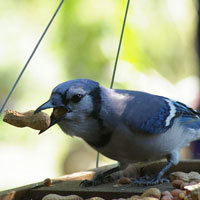
Peanuts and Tree Nuts — Nuts are high in protein and fat, and are valued by a number of backyard birds. It is important to note that all nuts fed to birds must be unsalted. Offer whole peanuts to jays, nuthatches and other birds bold enough to crack the shell. When you see a bird fly off with a whole peanut, you'll understand why they are tops on the entertainment scale. Shelled peanuts also attract woodpeckers, nuthatches, chickadees and house sparrows to name a few. Peanuts and other nuts are susceptible to mold and may turn rancid in the summer. Only distribute as many as the birds will eat in a few days.
Milo — Milo is a sorghum grain that looks a great deal like red millet. It is a cheaper seed but not as palatable to birds and therefore often considered a waste seed in the Eastern half of the country. If you live in the Western United States, you'll find sparrows, doves, towhees, pheasant and quail favor milo.
Corn — Cracked corn is a cheaper feed and appealing to ground feeding birds. If you wish to discourage blackbirds and doves, don't distribute corn at your feeding stations. If you are trying to attract doves, quail and sparrows, scatter cracked corn on the ground. Ducks and wild turkey will love whole shelled corn (as will the squirrels).
Canary Grass — You will find canary grass seed in many of the mixes for finches and siskins. A good source of protein, this seed is often fed to small domestic birds as well.
Black and Red Rapeseed/Canola — This round black seed of the Brassica genus family is often found in mixes. It is another seed high in oil and is favored by chickadees, nuthatches and finches.
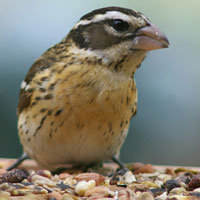 Mixes — There are a number of different bagged seed mixes widely available for specific birds. If you are lucky enough to live near a feed store or specialty bird store, you might be able to buy in bulk and create your own mixes suitable for the exact types of birds in your garden. Mixes may contain dried fruits and nuts, as well as seed. Many blends also add chili powder to deter squirrels. For a great discussion of seed mixes, visit this thread on the Dave's Garden Bird Watching Forum (available to both members and subscribers).
Mixes — There are a number of different bagged seed mixes widely available for specific birds. If you are lucky enough to live near a feed store or specialty bird store, you might be able to buy in bulk and create your own mixes suitable for the exact types of birds in your garden. Mixes may contain dried fruits and nuts, as well as seed. Many blends also add chili powder to deter squirrels. For a great discussion of seed mixes, visit this thread on the Dave's Garden Bird Watching Forum (available to both members and subscribers).
Hemp — The industrial hemp seed is actually a nut that is high in fat and are incredibly attractive to birds. Like Nyjer, hemp seeds are heat sterilized or steamed to prevent sprouting. Similar to nuts, the high oil content means that seeds can go rancid quickly. Industrial hemp seed is legal in the United States and is not to be confused with its cousin, marijuana.
Buckwheat, Wheat, Alfalfa and Oats — Not generally a choice for songbirds, these grains are common feed for game birds such as quail, pheasants, doves and pigeons.
![]()
![]()
![]()
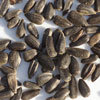
Black Oil Sunflower Seeds
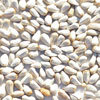
Safflower Seed
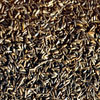
Nyjer Seed
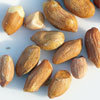
Shelled
Peanuts
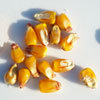
Corn
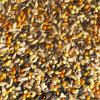
Finch Mix
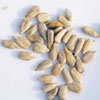
Hulled
Sunflower Seeds
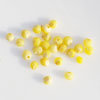
White Millet
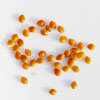
Red Millet
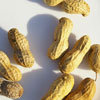
Peanuts
in the Shell
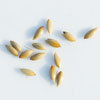
Canary Grass
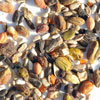
Woodpecker, Chickadee & Nuthatch Mix
![]()
![]()
![]()
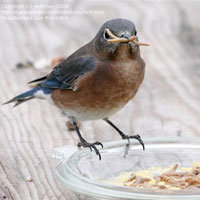 Mealworms — Insect eaters supplement their diet with mealworms in the winter months when food is scarce. Bluebirds love mealworms; adults gobble them up readily and will feed them to older babies in breeding season. Bluebirds aren't the only birds who enjoy these insects. Robins, mockingbirds and wrens will help themselves too, devouring the mealies in no time. If you are interested in feeding bluebirds only, consider a caged feeder that will limit entry to smaller birds. Mealworms can be purchased live, canned or dried. Live mealworms are available at pet stores and through mail-order/online suppliers.
Mealworms — Insect eaters supplement their diet with mealworms in the winter months when food is scarce. Bluebirds love mealworms; adults gobble them up readily and will feed them to older babies in breeding season. Bluebirds aren't the only birds who enjoy these insects. Robins, mockingbirds and wrens will help themselves too, devouring the mealies in no time. If you are interested in feeding bluebirds only, consider a caged feeder that will limit entry to smaller birds. Mealworms can be purchased live, canned or dried. Live mealworms are available at pet stores and through mail-order/online suppliers.
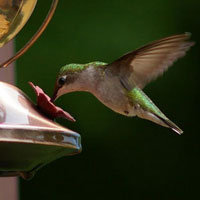 Dried Fruit — Dried fruit such as raisins and cranberries are good choices for berry-eating birds. Soak them overnight or use them dried in dish or platform feeders. You'll often find these in premium seed mixes at well-supplied stores.
Dried Fruit — Dried fruit such as raisins and cranberries are good choices for berry-eating birds. Soak them overnight or use them dried in dish or platform feeders. You'll often find these in premium seed mixes at well-supplied stores.
Fresh Fruit — Fresh oranges, grapes and apples are summer favorites of orioles, tanagers, woodpeckers, robins and waxwings to name a few. When the temperature drops, don't let that stop you from putting out fresh fruit.
Nectar — Hummingbirds are by far the most well known nectar eaters. It's not uncommon for orioles to try and sip from hummingbird feeders or their own version of the feeder. Other songbirds and woodpeckers may also be seen at the sugar water feeders.
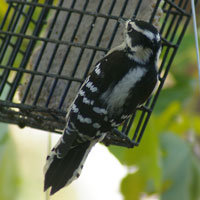 Suet — Made at home or store-purchased, suet is great source of fat for nearly all birds. It is an important staple in the winter because it is a source of heat and energy. Suet can be as simple as animal fat hung in mesh bags or a tasty recipe mix of seed, fruits, animal fat and peanut butter. In summer months, birds may enjoy a number of no-melt suet products on the market today.
Suet — Made at home or store-purchased, suet is great source of fat for nearly all birds. It is an important staple in the winter because it is a source of heat and energy. Suet can be as simple as animal fat hung in mesh bags or a tasty recipe mix of seed, fruits, animal fat and peanut butter. In summer months, birds may enjoy a number of no-melt suet products on the market today.
Grit — Since birds don't have teeth to chew, they use their gizzards to assist in grinding whole or harder seeds. This is where grit (small bits of sand, pebbles or shells) comes into the picture. Birds swallow grit into their gizzard where it grinds the whole seeds. You may make grit for birds with eggshells by following strict procedures found at the Cornell website.
One of the best ways to attract birds to your yard is to plant items with birds in mind. Bushes with berries, trees for cover plants that produce their own seed are ideal. Instead of deadheading, plan on leaving seed on many of your flowers. Plant a row of sunflowers for a fun late-summer show from goldfinch, chickadees and cardinals.
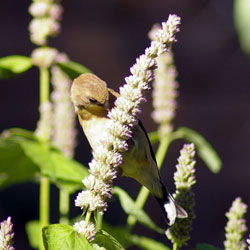
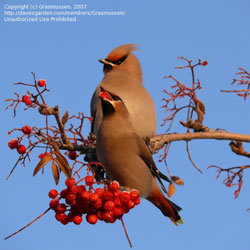
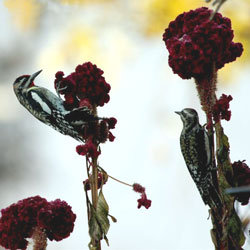
Popular Landscape Plants Used by Many Birds
AlderFor a great discussion on landscape plants for birds, visit this thread on the Bird Watching Forum.
When determining what food you'd like to offer, consider what birds you'd like to attract. To assist you, here's a short list of birds and what they eat. Click to make this chart larger.
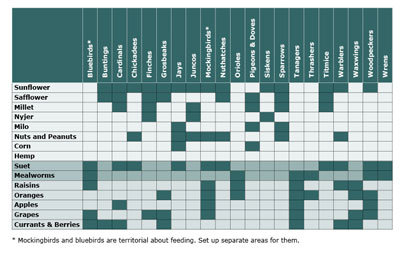
Supplementing wild food sources with purchased bird feed is a great way to bring the action close for your enjoyment. Before purchasing seed, determine what birds you are likely to entice. What obstacles might be in your way? For instance, if you live in an apartment or town home, your neighbors might not appreciate the mess that sunflower hulls leave. In this case, a no-waste mix or sunflower kernels are best. For those living in heavily wooded areas that are likely to see many woodpeckers, suet and nuts are in order! Wherever you live, know that the bird feeding business is thriving and you have many choices available. Remember that once you begin to feed birds, you should continue through the cold months, as birds come to rely on your feeding station. Consider feeding throughout the year to see migratory birds you otherwise might not encounter. Most of all, enjoy the nature center you have brought to your backyard with your bird buffet.
National Bird Feeding Society
Audubon Basic Bird Feeding
Affirming Sunflower’s Importance to Bird Feeding, Sunflower Magazine
Project Wildbird
Sialis
Audubon Bluebird Banquet Recipe
Suet Recipes on the Bird Watching Forum
Audubon Workshop Food and Seed
Wild Birds Forever
Wild Birds Unlimited
Main Street Seed and Supply Co.
eBirdseed.com
Wild Birds Online
Seed Mixes on the Bird Watching Forum
[1] Chart compiled from the following resources:
Audubon
Wild Birds Unlimited
Wild Birds Forever
Project Feeder Watch (Cornell)
Wild Bird Watching
Special thanks to "dellrose" and "grasmussen" for use of their lovely bird photos.
(Editor's Note: This article was originally published on December 1, 2008. Your comments are welcome, but please be aware that authors of previously published articles may not be able to respond to your questions.)
Copyright © www.100flowers.win Botanic Garden All Rights Reserved